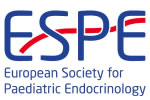hrp0097t5 | Section | ESPE2023
Clinical relevance of findings of the NGS panel for the pediatric patient with papillary thyroid carcinoma
Dujovne Noelia , Gazek Natalia , Vaiani Elisa , Ramirez Pablo , Perez Garrido Natalia , Marino Roxana , Lopez Marti Jessica , Ayarzabal Victor , Ciaccio Marta , Belgorosky Alicia , Herzovich Viviana
hrp0095p1-169 | Sex Differentiation, Gonads and Gynaecology, and Sex Endocrinology | ESPE2022
Analysis of the GHR gene poly¬morphism in a non-disgenetic 46,XY DSD cohort without molecular diagnosis.
Celeste Mattone Maria , Perez Garrido Natalia , Costanzo Mariana , Hidalgo Lorena , Berger Malena , Zoff Luciana , Sonia Baquedano Maria , Ramirez Pablo , Berensztein Esperanza , Ciaccio Marta , Marino Roxana , Belgorosky Alicia , Guercio Gabriela
hrp0082fc6.4 | Gonads & DSD | ESPE2014
Familial 46,XY Complete Female External Sex Development and Primary Amenorrhea Along with Hidden Gonad Tumors, Secondary to a Novel p.met64val SRY Gene Mutation
Vaiani Elisa , Malosetti Carmen , Marino Roxana , Ramirez Pablo , Garrido Natalia Perez , Berensztain Esperanza , Col Florencia Da , Bailez Marcela , Sala Josefina , Galluzzo Laura , Maceiras Mercedes , Lazzati Juan Manuel , Rivarola Marco , Belgorosky Alicia
hrp0089p2-p345 | Sex Differentiation, Gonads and Gynaecology or Sex Endocrinology P2 | ESPE2018
Histopathologic Characterization of Patients with 46,XX Testicular and Ovotesticular Disorders of Sex Development
Touzon Maria Sol , Mutti Maria Laura Galluzzo , Ramirez Pablo , Garrido Natalia Perez , Marino Roxana , Bailez Marcela , Costanzo Mariana , Guercio Gabriela , Vaiani Elisa , Ciaccio Marta , Rivarola Marco Aurelio , Belgorosky Alicia , Berensztein Esperanza
hrp0086fc7.1 | Gonads & DSD | ESPE2016
Early Loss of Germ Cells in Testis of Androgen Insensitivity Syndrome Patients
Aliberti Paula , Marino Roxana , Ramirez Pablo , Garrido Natalia Perez , Solari Alberto J. , Sciurano Roberta , Ponzio Roberto , Costanzo Mariana , Guercio Gabriela , Warman Diana M. , Mutti Maria L. Galluzzo , Lubieniecki Fabiana , Bailez Marcela , Rivarola Marco A. , Belgorosky Alicia , Berensztein Esperanza B.
hrp0086p1-p689 | Endocrinology and Multisystemic Diseases P1 | ESPE2016
Novel Germline Mutations in DICER1 Gene in Patients with Different Pediatric Hereditary Tumors
Marino Roxana , Galeano Jesica , Ramirez Pablo , Garrido Natalia Perez , Vaiani Elisa , Costanzo Mariana , Herzovich Viviana , Dujovne Noelia , Lubieniecki Fabiana , De la Rosa Laura , Obregon Gabriela , Chantada Guillermo , Aurelio Marco Rivarola , Belgorosky Alicia
hrp0098p1-87 | Pituitary, Neuroendocrinology and Puberty 1 | ESPE2024
Phenotypic characteristic of a large cohort of pediatrics Argentine patients with PSIS. High Prevalence of Mutations in ROBO1 gene
Isabel Di Palma María , Plomer Paula , Marino Roxana , Perez Garrido Natalia , Belgorosky Alicia , Ramirez Pablo , Manuel Lazatti Juan , Inés Perez Millán María , Perticarari Catalina , Martinez Mayer Julián , Ciaccio Marta
hrp0098p1-216 | Bone, Growth Plate and Mineral Metabolism 3 | ESPE2024
Characterization of a large cohort of 99 argentinian patients with hereditary hypophosphatemic rickets (HHR) followed in a single pediatric tertiary center
Viterbo Gisela , Del Pino Mariana , Aziz Mariana , Abbate Silvina , Perez Garrido Natalia , Ramirez Pablo , Saraco Nora , Tesan Fiorella , Ciaccio Marta , Gabriela Obregón María , Fano Virginia , Belgorosky Alicia , Marino Roxana



